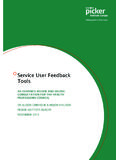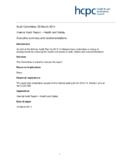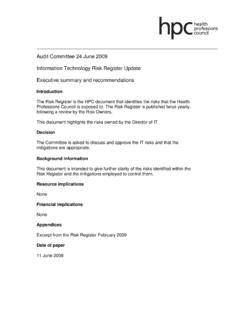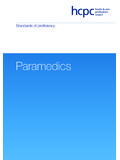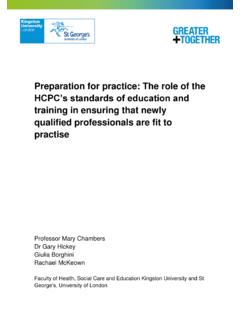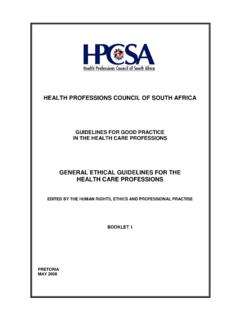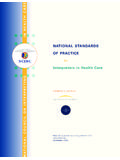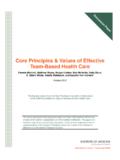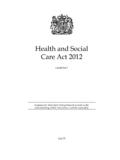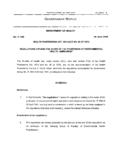Transcription of Confidentiality - HCPC - Health and Care …
1 Confidentiality guidance for registrantsInformation for registrants 2 Health and care professions CouncilConfidentiality guidance for registrantsContentsSection 1: About this document3 Language3 Section 2: Key principles4 Section 3: About us5 Who do we regulate?5 Section 4: Introduction6 Our standards of conduct, performance and ethics6 Confidentiality and the law7 Accessing and using information7 Section 5: What information is confidential?8 Section 6: Keeping information safe9 What our standards say9 Electronic records9 Section 7: Consent and confidentiality10 What our standards say10 What is consent?10 Capacity11 Children and young people11 Making decisions for people who lack capacity12 Section 8: Disclosing information with consent13 Working with other practitioners13 Other reasons13If a service user does not give their consent14 Section 9: Disclosing information without consent 15If the service user is unable to give their consent15 Public interest15 Section 10: Disclosing information by law16 Requests from service users16 Safeguarding16 Section 11: Disclosing information to regulators17 Reporting your concerns17 Identifiable information and fitness to practise17 Section 12: Confidentiality and accountability19 Section 13: More information20 Contact us20 Glossary21 Annex A: Data protection principles23 Glossary of terms used in annex A263 Health and care professions CouncilConfidentiality guidance for registrantsSection 1.
2 About this documentThis document provides guidance on some of theissues relating to how Health and careprofessionals handle information about serviceusers. We have written it mainly for ourregistrants, but it might also be helpful to potentialregistrants, employers and other people whowant to know how we expect professionals toapproach issues of document is not designed to replace localprocedures and is not meant to cover everysituation where problems can come up. However,it is meant to help you make informed andreasonable decisions relating to issues ofconfidentiality, in line with our you have any questions after reading thisdocument, please see the More information section on page 20. We also explain some of theterms and phrases we use throughout thisdocument in the glossary on page most of this guidance, when we refer to service users we mean patients, clients andother people who are directly affected by the care ,treatment or other services that registrantsprovide.
3 The broad principles set out in thisguidance also apply to registrants who provideservices to organisations rather than this document, you means a registrant and we and our refers to the Health and CareProfessions and care professions CouncilConfidentiality guidance for registrantsSection 2: Key principlesThis guidance cannot cover every situation whereproblems or challenges about confidentiality mightcome up. However, you should keep the followingprinciples in mind when handling information. Theguidance that follows builds on these principles toexplain should: take all reasonable steps to keep informationabout service users safe; make sure you have the service user s consentif you are passing on their information (unlessthere are good reasons not to, for example, it isnecessary to protect public safety or preventharm to other people); get express consent, in writing, if you are usingidentifiable information for reasons which arenot related to providing care , treatment or otherservices for them; only disclose identifiable information if it isnecessary, and, when it is, only disclose theminimum amount necessary; tell service users when you have disclosed theirinformation (if this is practical and possible); keep appropriate records of disclosure; keep up to date with relevant law and goodpractice; if appropriate, ask for advice from colleagues,professional bodies, unions, legal professionalsor us.
4 And make your own informed decisions aboutdisclosure and be able to justify and care professions CouncilConfidentiality guidance for registrantsSection 3: About usWe are the Health and care professions council (HCPC). We are a regulator and our main aim is toprotect the public. To do this, we keep a registerof professionals who meet our standards for theirtraining, professional skills, behaviour and and care professionals on our Register arecalled registrants . If registrants do not meet ourstandards, we can take action against them. Inserious cases, this may include removing themfrom the Register so that they can no registrants work in a variety of differentsettings and with a variety of different people. Inthis document, we refer to those who use or whoare affected by the services of our registrants as service users .Who do we regulate?We currently regulate the following professions . Arts therapists Biomedical scientists Chiropodists / podiatrists Clinical scientists Dietitians Hearing aid dispensers Occupational therapists Operating department practitioners Orthoptists Paramedics Physiotherapists Practitioner psychologists Prosthetists / orthotists Radiographers Social workers in England Speech and language therapists6 Health and care professions CouncilConfidentiality guidance for registrantsSection 4: IntroductionConfidentiality means protecting personalinformation.
5 This information might include detailsof a service user s lifestyle, family, Health or careneeds which they want to be kept users expect the Health and careprofessionals who are involved in their care ortreatment, or have access to information aboutthem, to protect their confidentiality at all confidentiality can affect the care orservices you provide, as service users will be lesslikely to provide the information you need to carefor them. Doing this may also affect the public sconfidence in all Health and care document builds on the principles outlined insection two and provides extra guidance aboutsome of the issues which come up aboutconfidentiality. It builds on the expectations ofhealth and care professionals outlined in ourstandards of conduct, performance and ethics. Our standards of conduct, performance andethicsThe following standards of conduct, performanceand ethics describe the professional behaviour weexpect from you. You must:1.
6 Promote and protect the interests of serviceusers and carers;2. communicate appropriately and effectively;3. work within the limits of your knowledge andskills;4. delegate appropriately;5. respect confidentiality;6. manage risk;7. report concerns about safety;8. be open when things go wrong;9. be honest and trustworthy; and10. keep records of your can download copies of these standardsfrom our website, or you can ask us to send youa copy. Please see the section More information on page our registrants work in a variety of settings androles, we have written our standards so that theyare relevant, as far as possible, to all registrantsand all professions . We have also written them ina way that means they can take account of anychanges in the law, technology or standards are flexible enough to allowregistrants and employers to take account of localcircumstances such as availability of resources to develop ways of working that are practical,effective and meet the needs of service have written this document to help you meetour standards.
7 However, there is often more thanone way to do this. As a Health and careprofessional, you need to make your owndecisions (based on your own judgement) aboutthe best way to meet our standards, takingaccount of your own practice and the needs ofyour service users. If someone raises concernsabout your practice, we will take account of anysteps you have taken, including following thisguidance, when we decide whether you have metour and care professions CouncilConfidentiality guidance for registrantsConfidentiality and the lawYou have a professional and legal responsibility torespect and protect the confidentiality of serviceusers at all times. It is a professional responsibility because ourstandards are there to protect the public and saythat you should protect the confidentiality ofservice users at all times. Confidentiality issuescan affect your is a legal responsibility because of the principlesset by law, which say that professionals have aduty to protect the confidentiality of the peoplethey have a professional relationship with.
8 The lawalso says how you should keep, handle anddisclose guidance draws on relevant laws that affecthealth and care professionals and their serviceusers. You are not expected to be an expert onthe law, but you must keep up to date with andmeet your legal responsibilities. Where helpful, wehave referred directly to specific legislation whichcovers issues related to handling information,consent and capacity (see section 7 for moreinformation about these).Apart from the law, there is a large amount ofguidance produced by other organisations, suchas professional bodies, which may apply to you. Ifyou are employed, your employer is also likely tohave policies about confidentiality and sharinginformation. You should keep up to date with andfollow any guidance or policies that are relevant toyour practice. Accessing and using informationWhen we refer to using information, we meanany way information is handled. This includesaccessing information, as well as disclosinginformation to third parties and using informationin research or guidance focuses mainly on disclosing orsharing information with other professionals orthird parties.
9 However, accessing information(including care records) without good reason,permission or authorisation is considered to bebreaking confidentiality, even if you do not thenshare the information with a third party. Youshould be sure that you have a legitimate reasonfor accessing information about service users, forexample where you need it to provide care ,treatment or other services. For other reasons youare likely to need specific permission from theservice user. 8 Health and care professions CouncilConfidentiality guidance for registrantsSection 5: What information is confidential?Information about a service user can be identifiable or anonymised . By identifiableinformation we mean any information you holdabout a service user that could identify them. Youmust treat this information as confidential. Identifiable information can include: personal details, such as names andaddresses; information about a service user s Health ,treatment or care that could identify them; photos, videos or other images; and other information that a service user, familymember or carer shares with you that is notstrictly related to the care , treatment or otherservices you provide.
10 Anonymised information is information about aservice user that has had all identifiableinformation removed from it and where there islittle or no risk of a service user being identifiedfrom the information available. You may be able toshare anonymised information more openly insome circumstances. However, you shouldalways consider carefully what you are sharingand who you are sharing it with. 9 Health and care professions CouncilConfidentiality guidance for registrantsSection 6: Keeping information safeWhat our standards sayOur standards of conduct, performance andethics say that: You must treat information about service users asconfidential ( )and You must keep records secure by protecting themfrom loss, damage or inappropriate access. ( )This means that you need to take all reasonablesteps to protect information about service reasonable steps , we mean that you need totake sensible, practical measures to make surethat you keep the information safe.

